Impact of Detergent Type, Detergent Concentration, and Friction Modifiers on PM-PN Emissions in an SI Engine Using EEPS
Abstract
1. Introduction
2. Goals and Motivation
- Develop testing procedures ensuring stability and repeatability of PM-PN emissions using the TSI EEPS system.
- Evaluate the time required for emissions to stabilize at road load.
- Determine the impact of deposit control additives and concentrations on PM-PN emissions.
- Determine the effect fuel-based friction modifiers have on PM-PN emissions.
- Calculate the PN-to-PM ratio at multiple operating conditions with the inclusion of ultrafine particles (particle diameter less than 23 nm).
3. Experimental Setup
3.1. Test Engine
3.2. Instrumentation and Controls
3.3. Exhaust Particle Emissions Sizer (EEPS)
- Coagulation;
- Thermophoretic losses;
- Nucleation;
- Impaction losses;
- Diffusion losses;
- Sample line condensation.
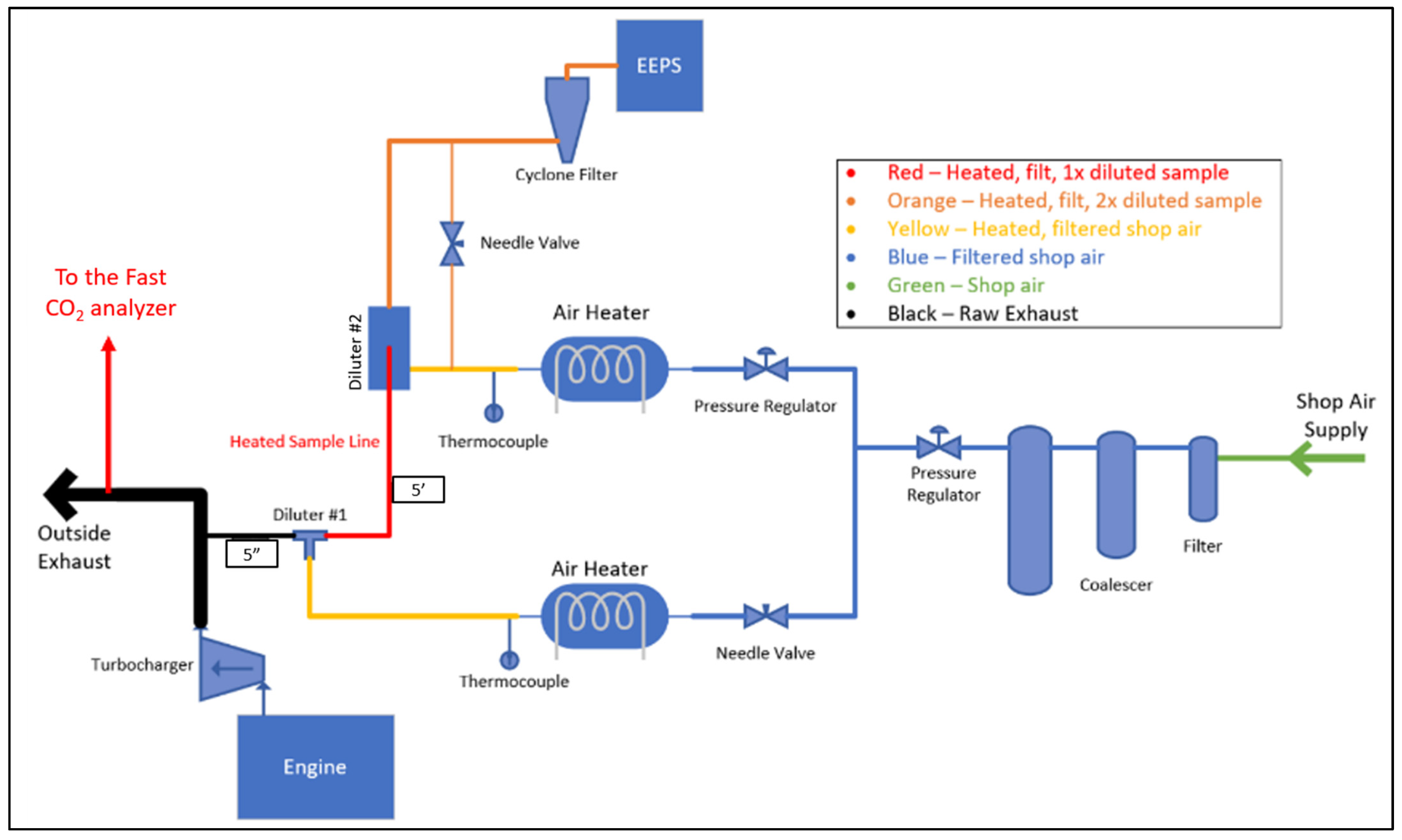
4. Methodology
4.1. Operating Conditions
- Road Load: 2200 RPM-4.75 bar BMEP;
- Cold Start: 1400 RPM-2.25 bar BMEP;
- High Load: 3000 RPM-16 bar BMEP.
4.2. Test Procedure
4.3. Settling Period
4.4. Test Fluids
4.5. Test Matrix
- LAC;
- 1×TT;
- 3×TT.
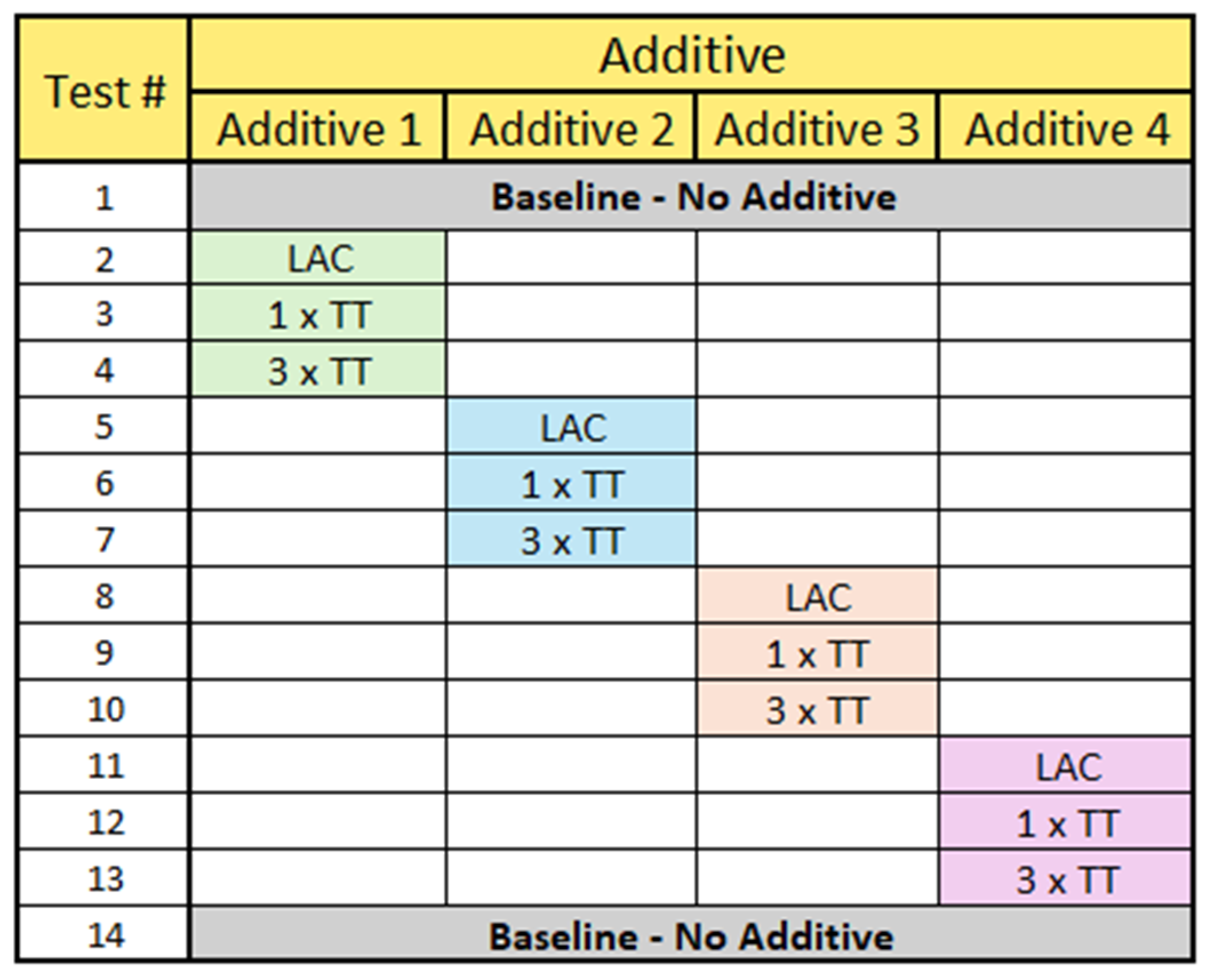
4.6. Density Correction for Particulate Mass Calculation
5. Results
5.1. EEPS Reference Checks
5.2. Settling Time
5.3. PM-PN Emissions
6. Road Load Condition
- Additive 2 showed the highest PM-PN emissions at the 1×TT treat rate.
- Conversely, Additive 1 and Additive 3 showed the lowest emissions at the 1×TT treat rate.
7. Cold Start Condition
8. High Load Condition
9. Particle Number—Particulate Mass Ratio
10. Conclusions
- EEPS repeatability: The Exhaust Emissions Particle Sizer (EEPS) showed good repeatability throughout the duration of the project, with a COV of less than 6% for the PM-PN emissions.
- Settling time: The majority of tests achieved emissions stabilization within 6 h of running at road load. The settling time increased with additive concentration. The additive with the friction modifier was the only one for which the PM-PN emissions did not settle for a 1×TT treat rate.
- Road Load: At the road load condition, the three deposit control additives (DCAs) without friction modifiers reduced particulate mass (PM) and particle number (PN) emissions compared to the baseline, but the effect varied nonlinearly with concentration and additive chemistry. The inclusion of the friction modifier caused a substantial increase in the PM-PN emissions for all treat rates. The increase in particle number at the LAC, 1×TT, and 3×TT concentrations of the Additive 3 plus Friction Modifier combination was 19%, 63%, and 56%, respectively, while the increase in particulate matter was 30%, 74%, and 80%, respectively.
- Cold Start: The majority of additive and treat rate combinations displayed a reduction in PM-PN emissions. This includes the Additive 3 plus Friction Modifier combination.
- High Load: No specific trend was observed at the high load condition. For all additives without the FM, the 3×TT treatment rate had lower emissions as compared to the baseline. The Additive 3 plus Friction Modifier combination showed an increase in the PM-PN emissions at the high load condition, with the LAC treat rate showing the highest increase (49% PN emissions, 52% PM emissions).
- PN-to-PM ratios: The measured PN-to-PM ratios were 4–5 times higher than the previous literature values (approximately 2.5 × 1012 #/mg), primarily due to the inclusion of particles below 23 nm in the EEPS measurements without a volatile particle remover (VPR). The discrepancy is reduced with the exclusion of ultrafine particles in the PN value, although the PN/PM ratios observed in this study are still 2–3 times higher.
11. Potential Future Work
Author Contributions
Funding
Data Availability Statement
Acknowledgments
Conflicts of Interest
Abbreviations and Definitions
| APSRC | Advanced Power Systems Research Center |
| BMEP | Brake Mean Effective Pressure |
| bTDC | Before Top Dead Center |
| °CA | Crank Angle |
| CCD | Combustion Chamber Deposit |
| COV | Coefficient of Variation |
| DCA | Deposit Control Additive |
| DOHC | Dual Overhead Camshaft |
| ECL | Exhaust Cam Centerline |
| ECU | Electronic Control Unit |
| EEPS | Exhaust Emissions Particle Sizer |
| EOI | End of Injection |
| EPA | Environmental Protection Agency |
| FATG | Fuel Additives Task Group |
| FM | Friction Modifier |
| FTP | Federal Test Procedure |
| GM | General Motors |
| GDI | Gasoline Direct Injection |
| ICL | Intake Cam Centerline |
| LAC | Least Allowable Concentration |
| LP | Locked Piston |
| MBT | Maximum Brake Torque |
| MTU | Michigan Technological University |
| NI | National Instruments |
| PM | Particulate Mass |
| PMP | Particle Measurement Program |
| PN | Particle Number |
| SI | Spark Ignition |
| SOI | Start of Injection |
| TT | TOP TIERTM |
| VPR | Volatile Particle Remover |
Appendix A
- EEPS Sense Checks
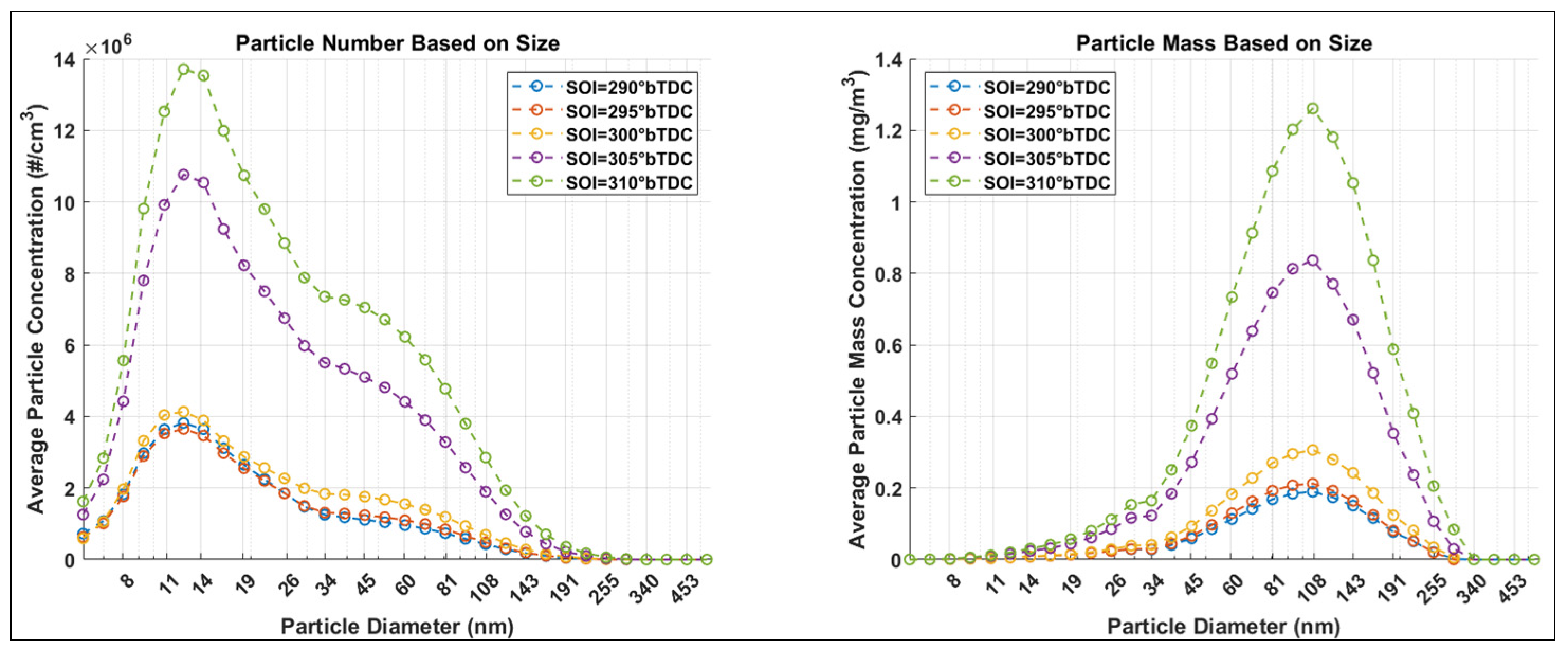
- EEPS Nucleation and Impaction Losses

- Settling Time
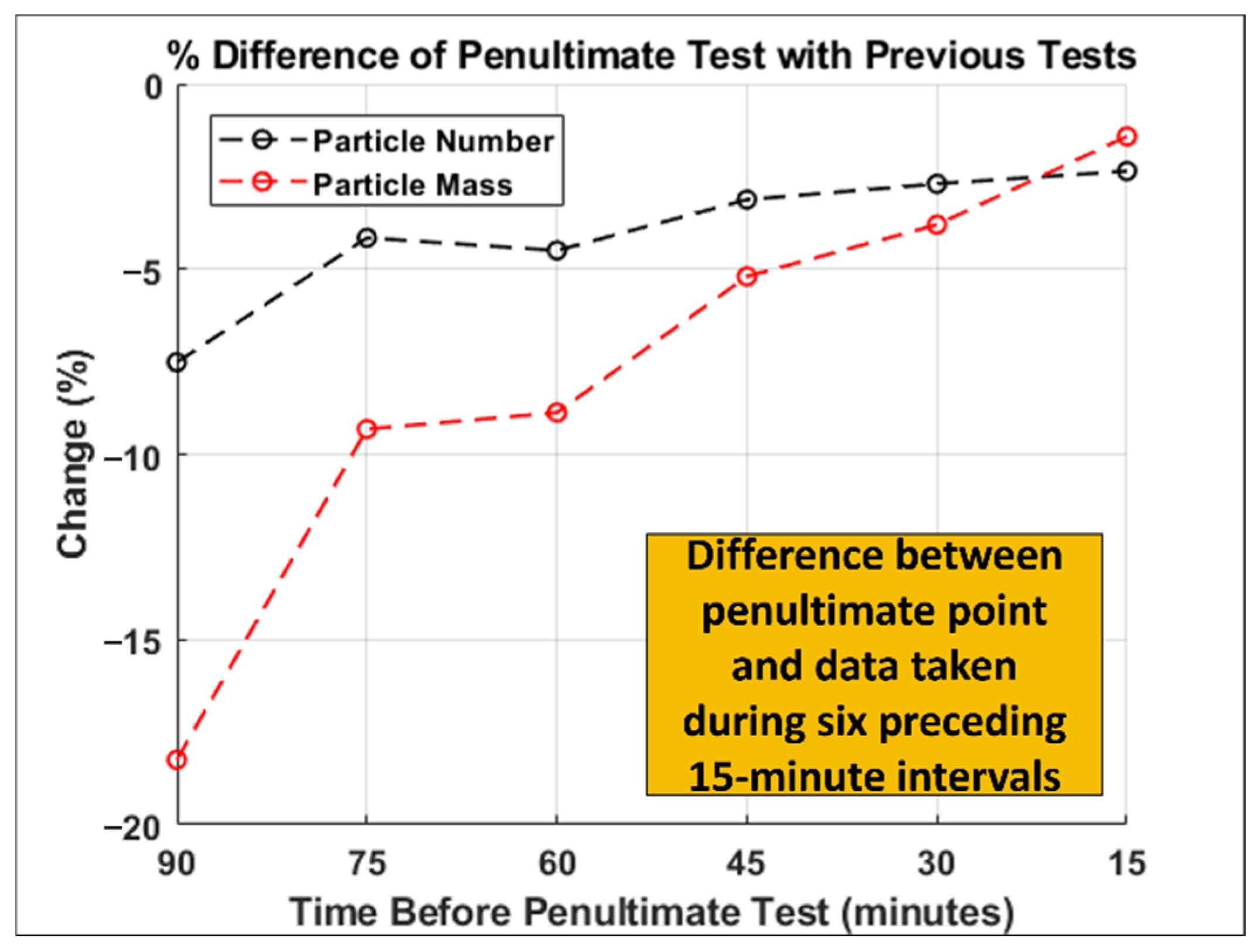
- EEPS Reference Checks
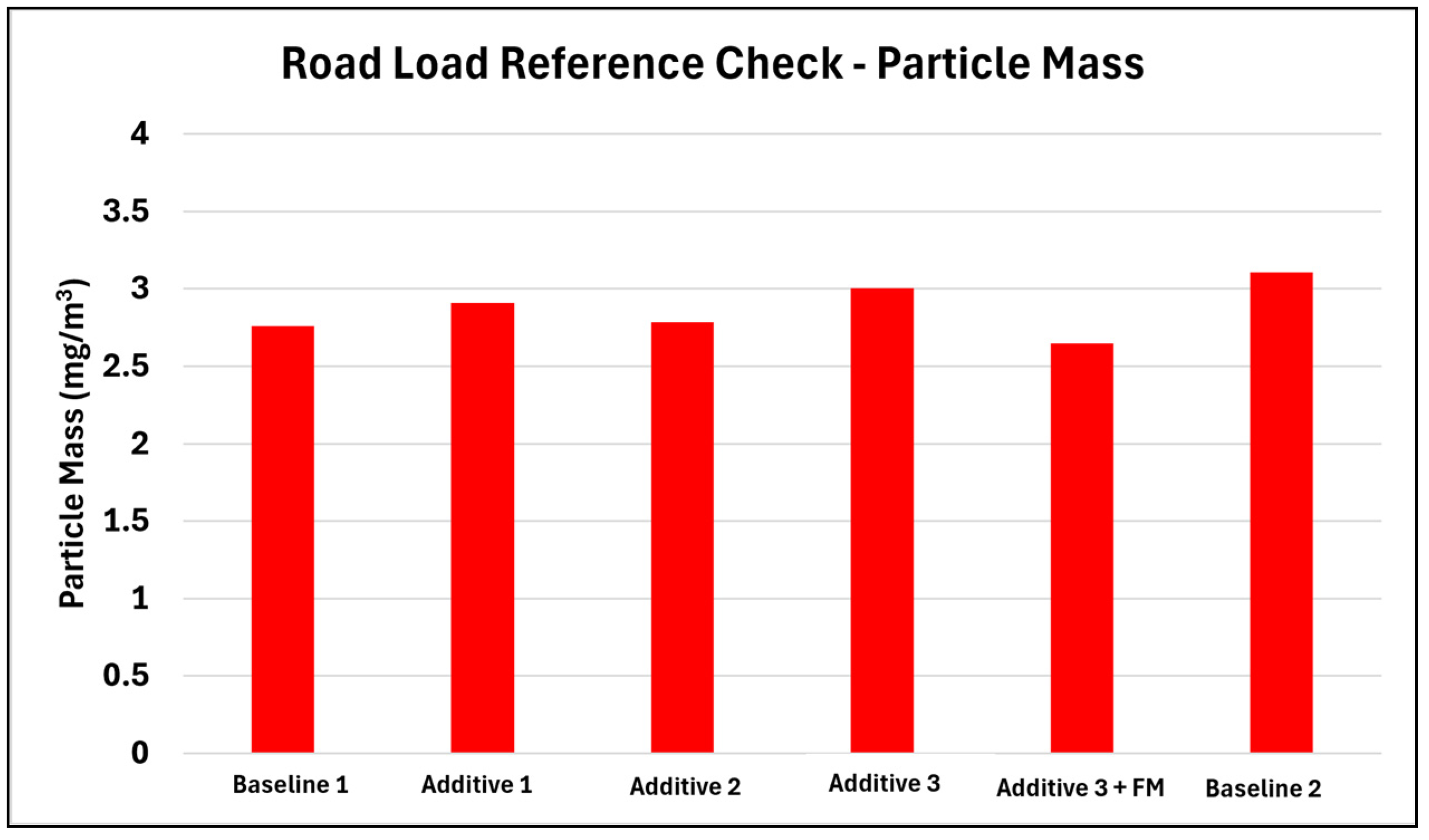
References
- Ristovski, Z.D.; Miljevic, B.; Surawski, N.C.; Morawska, L.; Fong, K.M.; Goh, F.; Yang, I.A. Respiratory health effects of diesel particulate matter. Respirology 2012, 17, 201–212. [Google Scholar] [CrossRef] [PubMed]
- Satsangi, D.P.; Agarwal, A.K. Particulate matter and its impact on human health in urban settings. In Methanol and the Alternate Fuel Economy; Springer: Berlin/Heidelberg, Germany, 2018; pp. 213–231. [Google Scholar]
- Maricq, M.M. Engine, aftertreatment, fuel quality and non-tailpipe achievements to lower gasoline vehicle PM emissions: Literature review and future prospects. Sci. Total Environ. 2023, 866, 161225. [Google Scholar] [CrossRef] [PubMed]
- Heywood, J. Internal Combustion Engine Fundamentals; McGraw-Hill Education: New York, NY, USA, 2018. [Google Scholar]
- Fang, T.; Wang, L.; Wang, Z. Particulate matter emissions from gasoline direct injection engines: Research review. J. Automot. Saf. Energy 2017, 8, 226. [Google Scholar]
- Saliba, G.; Saleh, R.; Zhao, Y.; Presto, A.A.; Lambe, A.T.; Frodin, B.; Sardar, S.; Maldonado, H.; Maddox, C.; May, A.A. Comparison of gasoline direct-injection (GDI) and port fuel injection (PFI) vehicle emissions: Emission certification standards, cold-start, secondary organic aerosol formation potential, and potential climate impacts. Environ. Sci. Technol. 2017, 51, 6542–6552. [Google Scholar] [CrossRef] [PubMed]
- Leach, F.; Chapman, E.; Jetter, J.J.; Rubino, L.; Christensen, E.D.; St. John, P.C.; Fioroni, G.M.; McCormick, R.L. A review and perspective on particulate matter indices linking fuel composition to particulate emissions from gasoline engines. SAE Int. J. Fuels Lubr. 2022, 15, 3–28. [Google Scholar] [CrossRef]
- Joshi, A.; Johnson, T.V. Gasoline particulate filters—A review. Emiss. Control Sci. Technol. 2018, 4, 219–239. [Google Scholar] [CrossRef]
- Khalek, I.A.; Bougher, T.; Jetter, J.J. Particle emissions from a 2009 gasoline direct injection engine using different commercially available fuels. SAE Int. J. Fuels Lubr. 2010, 3, 623–637. [Google Scholar] [CrossRef]
- Maricq, M.M.; Szente, J.; Loos, M.; Vogt, R. Motor vehicle PM emissions measurement at LEV III levels. SAE Int. J. Engines 2011, 4, 597–609. [Google Scholar] [CrossRef]
- Yamada, H.; Inomata, S.; Tanimoto, H. Particle and VOC emissions from stoichiometric gasoline direct injection vehicles and correlation between particle number and mass emissions. Emiss. Control Sci. Technol. 2017, 3, 135–141. [Google Scholar] [CrossRef]
- Giechaskiel, B.; Manfredi, U.; Martini, G. Engine exhaust solid sub-23 nm particles: I. literature survey. SAE Int. J. Fuels Lubr. 2014, 7, 950–964. [Google Scholar] [CrossRef]
- Alanen, J.; Saukko, E.; Lehtoranta, K.; Murtonen, T.; Timonen, H.; Hillamo, R.; Karjalainen, P.; Kuuluvainen, H.; Harra, J.; Keskinen, J. The formation and physical properties of the particle emissions from a natural gas engine. Fuel 2015, 162, 155–161. [Google Scholar] [CrossRef]
- Leach, F.; Lewis, A.; Akehurst, S.; Turner, J.; Richardson, D. Sub-23 nm Particulate Emissions from a Highly Boosted GDI Engine; SAE Technical Paper; SAE International: Warrendale, PA, USA, 2019. [Google Scholar]
- Leach, F.; Knorsch, T.; Laidig, C.; Wiese, W. A review of the requirements for injection systems and the effects of fuel quality on particulate emissions from GDI engines. In Proceedings of the SAE International Powertrains, Fuels & Lubricants Meeting 2018, Heidelberg, Germany, 17–19 September 2018. [Google Scholar]
- Monroe, R.; Studzinski, W.; Parsons, J.L.; La, C.; Sittner, K. Engine particulate emissions as a function of gasoline deposit control additive. SAE Int. J. Fuels Lubr. 2021, 14, 3–12. [Google Scholar] [CrossRef]
- Kuo, C.-H.; Smocha, R.; Loeper, P.; Mukkada, N.; Green, F.S. Aftermarket Fuel Additives and Their Effects on GDI Injector Performance and Particulate Emissions; SAE Technical Paper; SAE International: Warrendale, PA, USA, 2022. [Google Scholar]
- Zhang, W.; Ma, X.; Lu, X.; Shui, S.; Wu, K.; Macias, J.; Shen, Y.; Yang, C.; Li, G. Impact of Fuel Properties on GDI Injector Deposit Formation and Particulate Matter Emissions; SAE Technical Paper; SAE International: Warrendale, PA, USA, 2020. [Google Scholar]
- Chapman, E.; Studzinski, W.; Monroe, R.; Tolou, A.; Wagle, M.; Ciaravino, J.; Tomazic, D. Impact of Fuel Detergent Type and Concentration on the Rate and Severity of Stochastic Preignition in a Turbocharged Spark Ignition Direct Injection Gasoline Engine; SAE International: Warrendale, PA, USA, 2021. [Google Scholar]
- Tang, Z.; Li, S. A review of recent developments of friction modifiers for liquid lubricants (2007–present). Curr. Opin. Solid State Mater. Sci. 2014, 18, 119–139. [Google Scholar] [CrossRef]
- Guegan, J.; Southby, M.; Spikes, H. Friction modifier additives, synergies and antagonisms. Tribol. Lett. 2019, 67, 83. [Google Scholar] [CrossRef]
- SAE International. J3160: Recommended Practice for Improving Measurement Quality of Particle Number Counting Devices; SAE International: Warrendale, PA, USA, 2020. [Google Scholar]
- Park, K.; Cao, F.; Kittelson, D.B.; McMurry, P.H. Relationship between particle mass and mobility for diesel exhaust particles. Environ. Sci. Technol. 2003, 37, 577–583. [Google Scholar] [CrossRef] [PubMed]
- Maricq, M.M.; Xu, N. The effective density and fractal dimension of soot particles from premixed flames and motor vehicle exhaust. J. Aerosol Sci. 2004, 35, 1251–1274. [Google Scholar] [CrossRef]
- Quiros, D.C.; Hu, S.; Hu, S.; Lee, E.S.; Sardar, S.; Wang, X.; Olfert, J.S.; Jung, H.S.; Zhu, Y.; Huai, T. Particle effective density and mass during steady-state operation of GDI, PFI, and diesel passenger cars. J. Aerosol Sci. 2015, 83, 39–54. [Google Scholar] [CrossRef]
- Xue, J.; Li, Y.; Quiros, D.; Wang, X.; Durbin, T.D.; Johnson, K.C.; Karavalakis, G.; Hu, S.; Huai, T.; Ayala, A. Using a new inversion matrix for a fast-sizing spectrometer and a photo-acoustic instrument to determine suspended particulate mass over a transient cycle for light-duty vehicles. Aerosol Sci. Technol. 2016, 50, 1227–1238. [Google Scholar] [CrossRef]
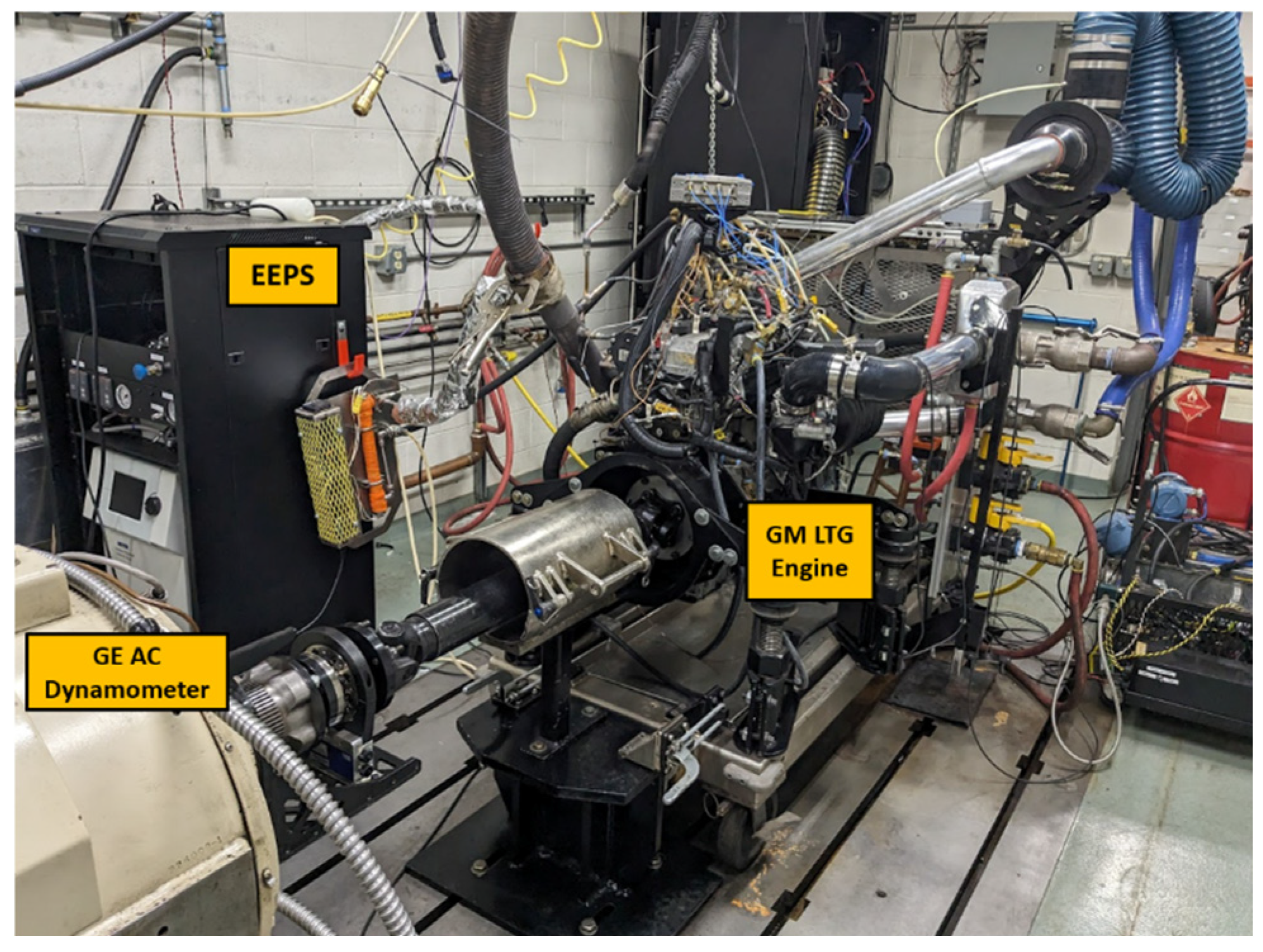

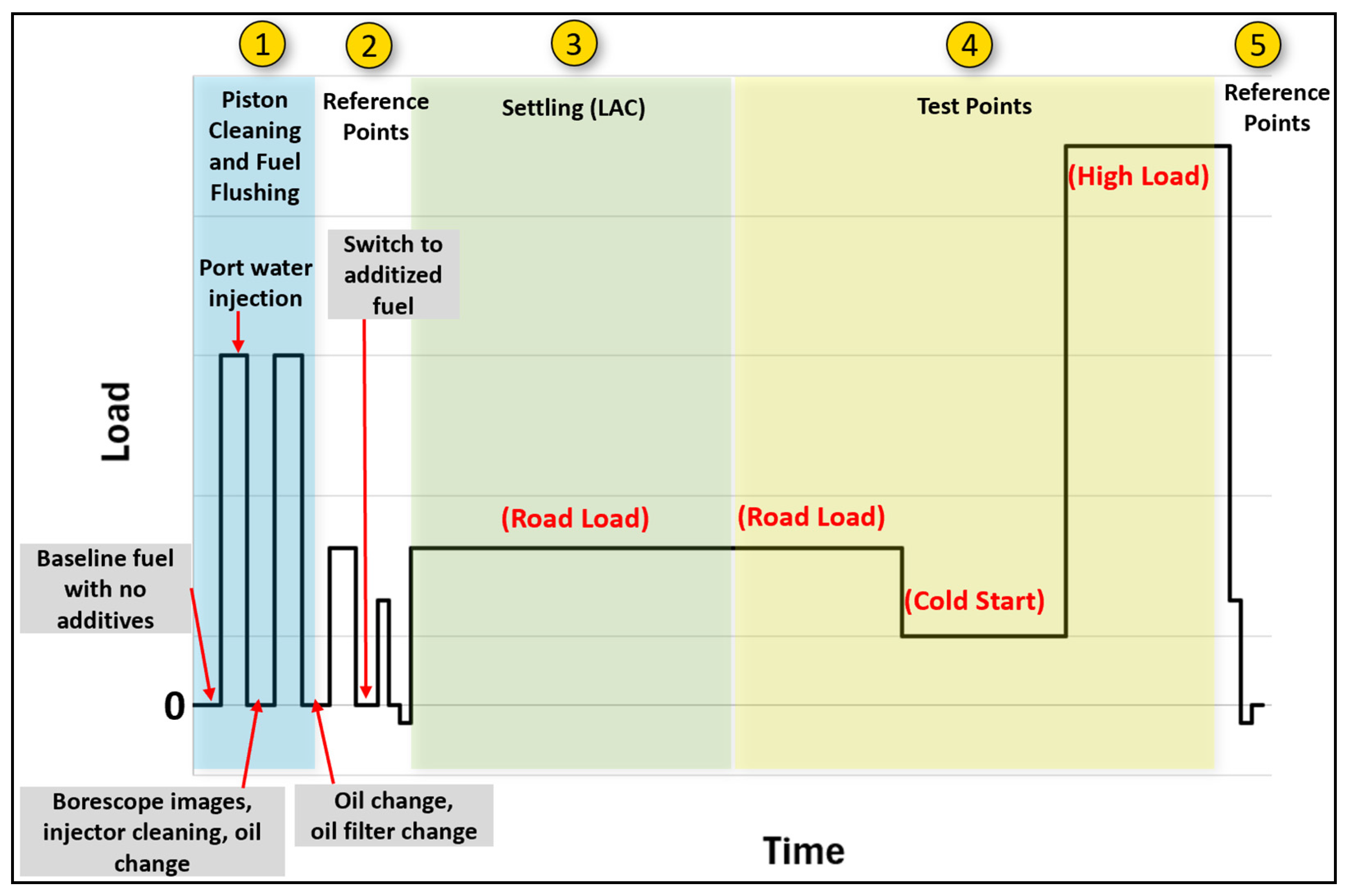
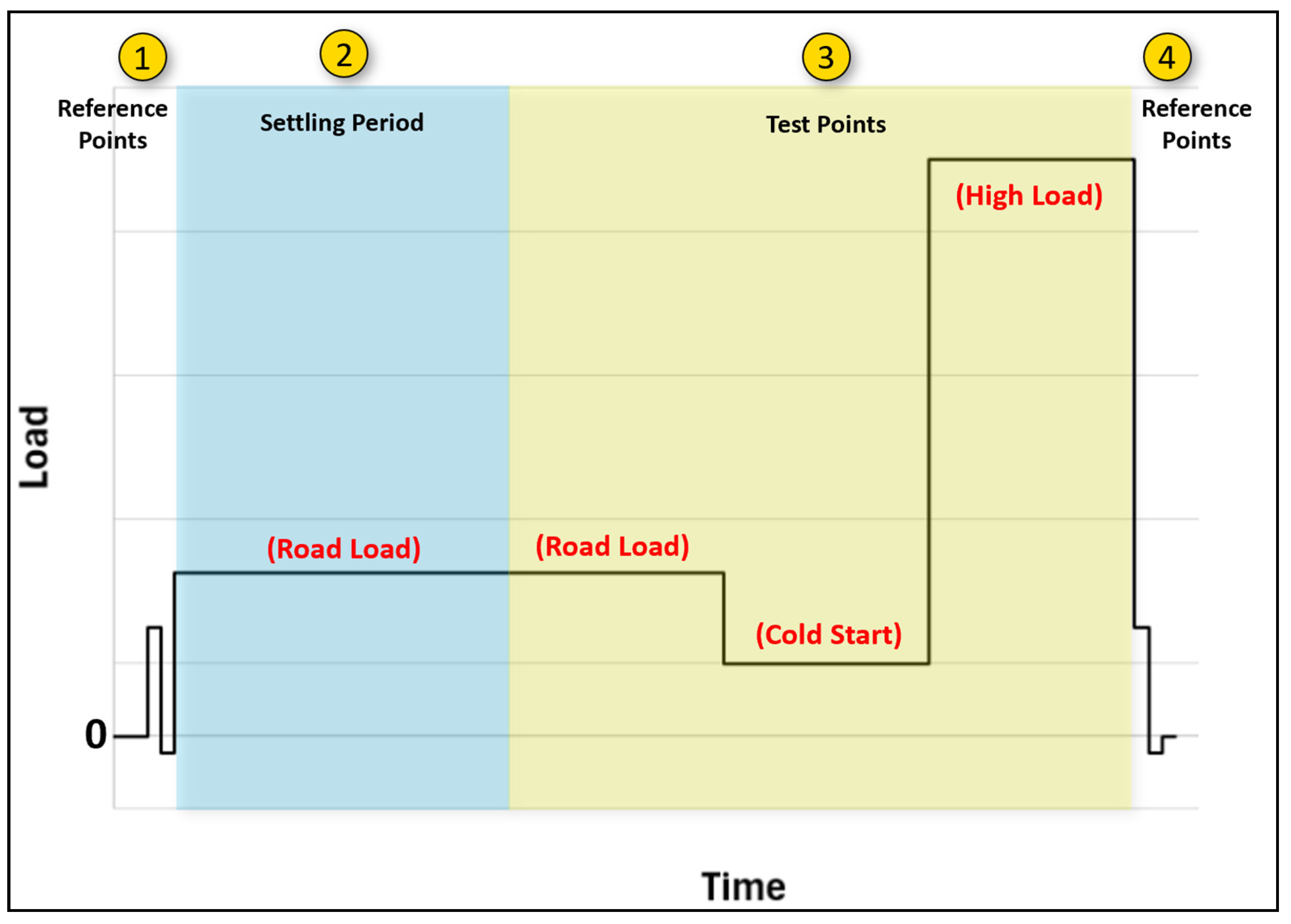



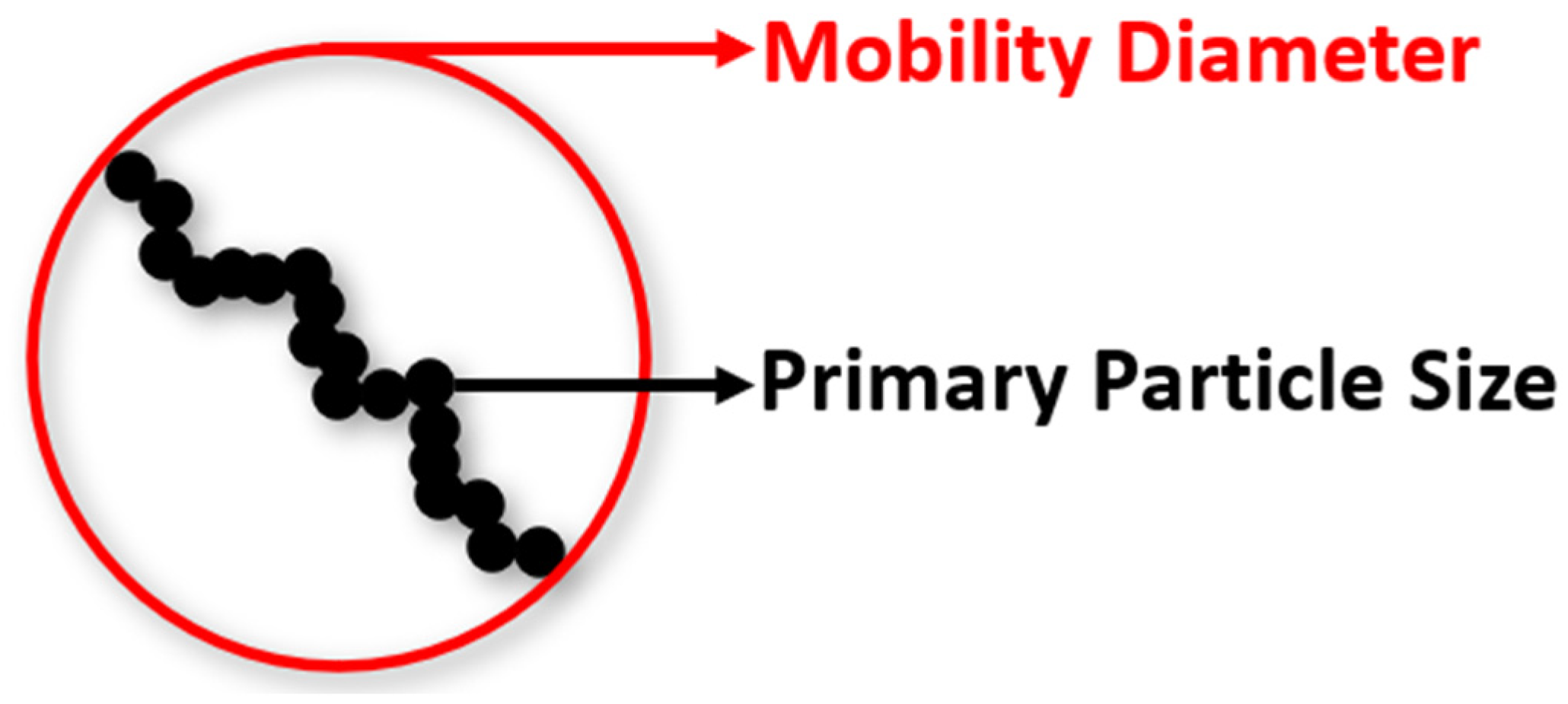
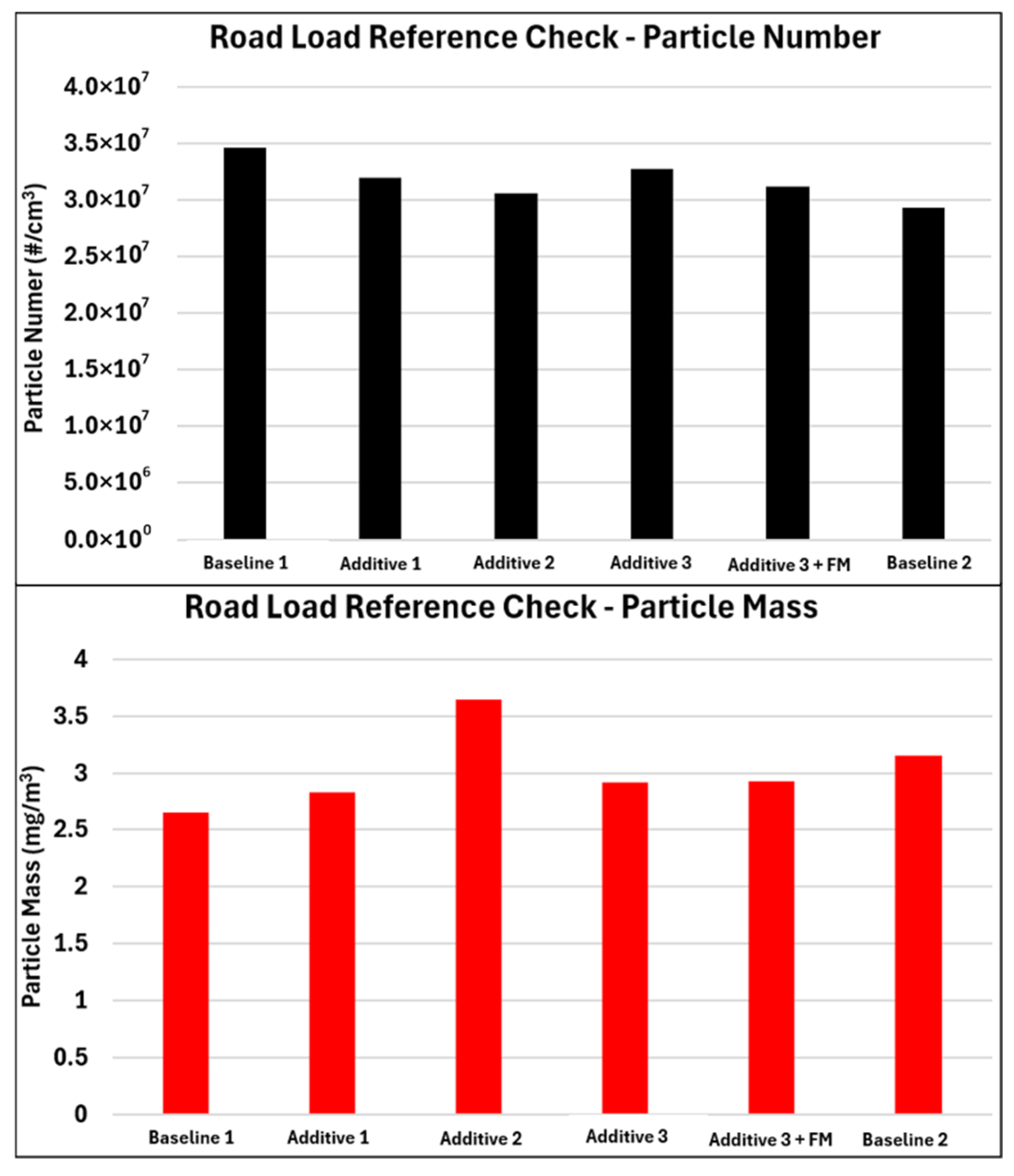
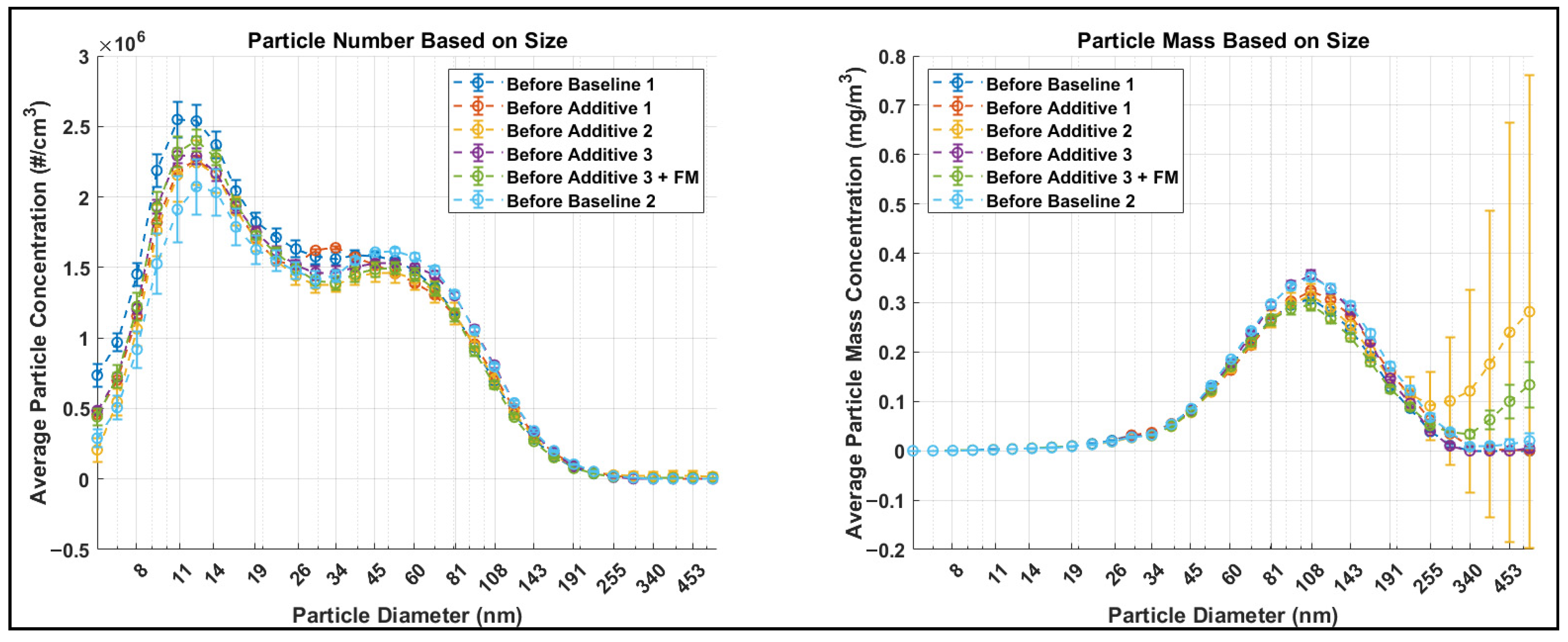

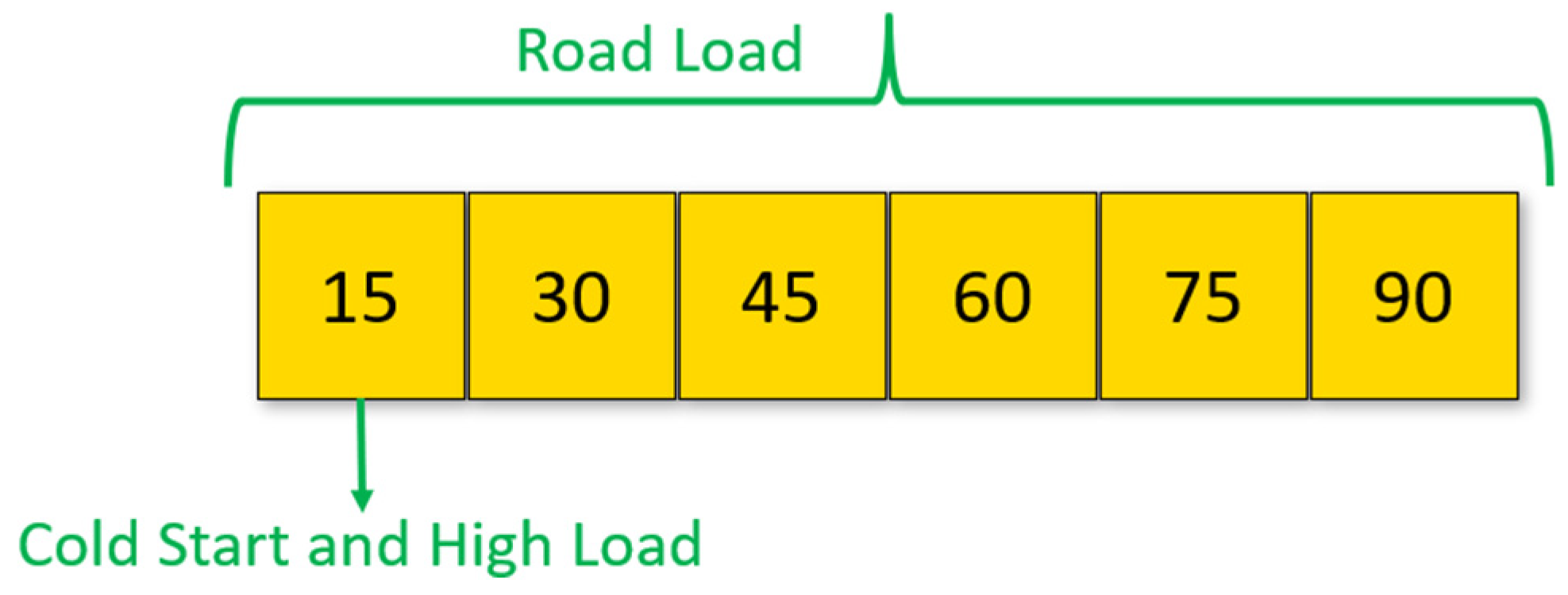
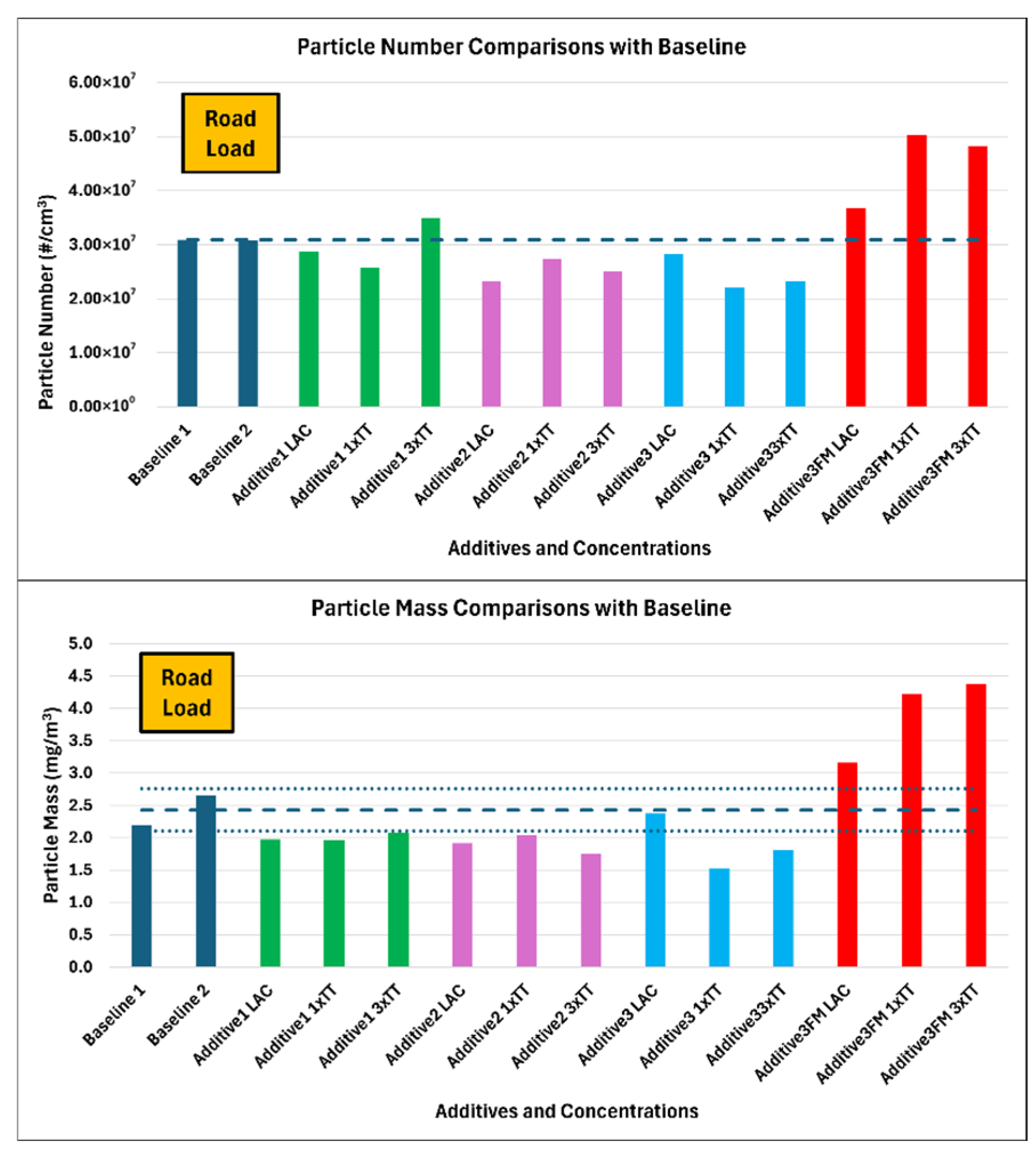
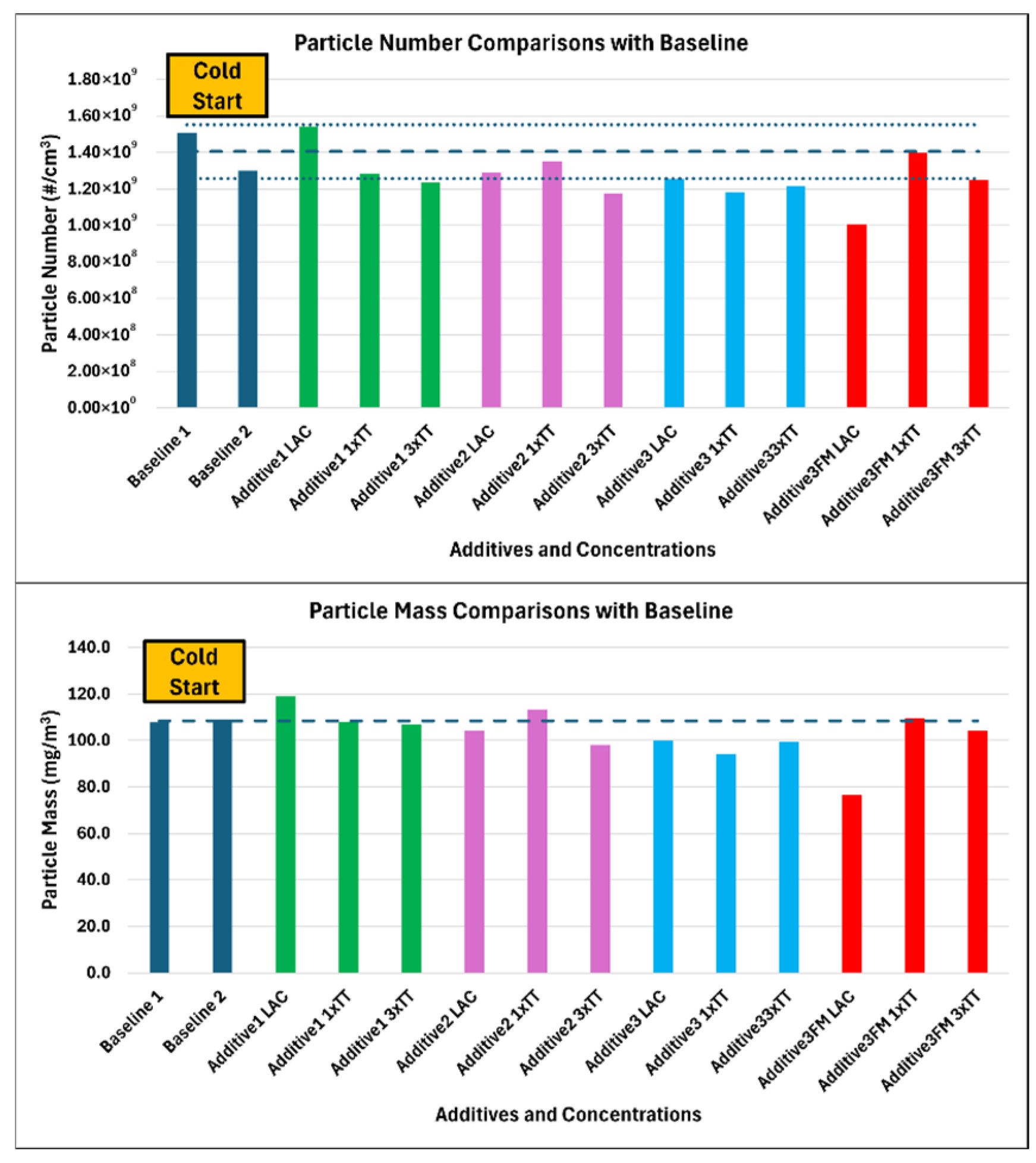
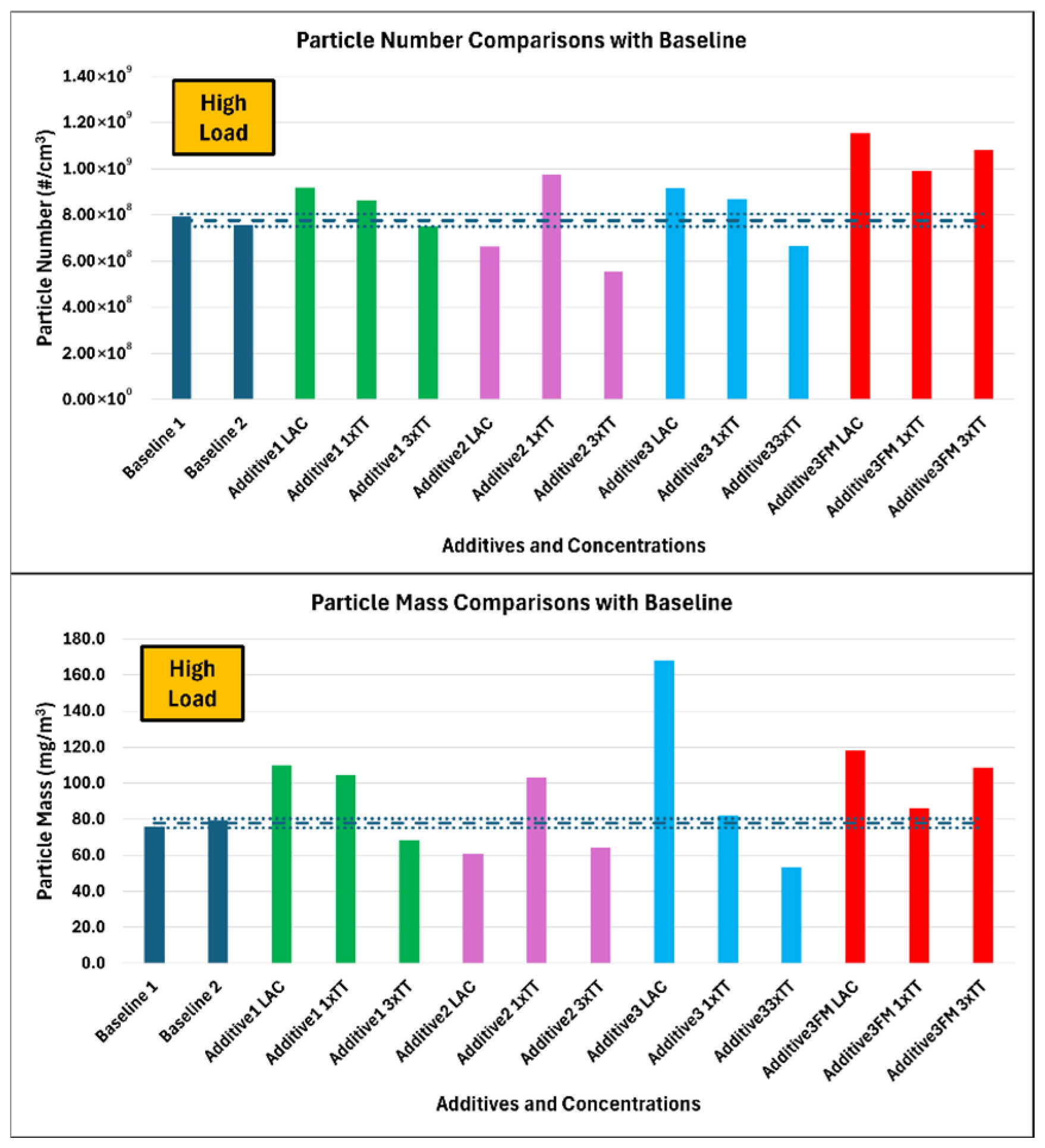
| Regulation Type | EPA Tier 3 (United States) | Euro 6d (European Union) |
|---|---|---|
| Particulate Mass | 3 mg/mile (approx. 1.86 mg/km) | 4.5 mg/km |
| Particulate Number | No limit | 6 × 1011 particles/km |
| Parameter | Description |
|---|---|
| Model | GM LTG |
| Bore (mm) | 86 |
| Stroke (mm) | 86 |
| Connecting Rod Length (mm) | 152.5 |
| Wrist Pin Offset (mm) | 0.6 |
| Compression Ratio (-) | 9.5 |
| Total Displacement Volume (L) | 2 |
| Valve Train Specification | DOHC |
| Camshaft Phasing Ranges | 31° Intake/Exhaust Cam Angle |
| Intake Charge Delivery | Turbocharged and Intercooled |
| Fuel Delivery | Direct Injection (Side Mounted Injector) |
| Engine Control System | MoTeC M142 |
| Ignition System | Coil-On-Plug |
| Oil Cooling | Block-Mounted Cooler |
| Coolant | DexCool @ 50/50 Mix with Reverse Osmosis Water |
| Operating Condition | ICL | ECL | Fuel Rail Pressure | SOI | EOI2 | Fuel Split Factor | Lambda | Spark | IAT | Coolant Temp. | Oil Temp. |
|---|---|---|---|---|---|---|---|---|---|---|---|
| Units | °From LP | °From LP | Bar | °bTDC | °bTDC | -- | -- | °bTDC | °C | °C | °C |
| Road Load | 20 | 13 | 184 | 277 | -- | -- | 1 | MBT | 30 | 90 | 90 |
| Cold Start | 10 | 16 | 90 | 240 | 56 | 0.6/0.4 | 1 | −12 | 30 | 40 | 40 |
| High Load | 11.4 | 5.2 | 200 | 288 | -- | -- | 1 | Knock Limit | 35 | 90 | 90 |
| Concentration | Particle Number Increase (%) | Particulate Mass Increase (%) |
|---|---|---|
| LAC | 19.0 | 30.1 |
| 1×TT | 62.7 | 73.6 |
| 3×TT | 56.2 | 80.1 |
| Concentration | Particle Number Increase (%) | Particulate Mass Increase (%) |
|---|---|---|
| LAC | 48.5 | 51.7 |
| 1×TT | 27.3 | 10.9 |
| 3×TT | 39.2 | 39.4 |
| Particle Number to Particulate Mass Ratio (Particles/mg) | ||
|---|---|---|
| Road Load (90-min Average) | Cold Start (15-min Average) | High Load (15-min Average) |
| 1.27 × 1013 | 1.3 × 1013 | 9.99 × 1012 |
| Particle Number to Particle Mass Ratio (Particles/mg) | ||
|---|---|---|
| Road Load (90 min Average) | Cold Start (15 min Average) | High Load (15 min Average) |
| 6.31 × 1012 | 5.96 × 1012 | 5.74 × 1012 |
Disclaimer/Publisher’s Note: The statements, opinions and data contained in all publications are solely those of the individual author(s) and contributor(s) and not of MDPI and/or the editor(s). MDPI and/or the editor(s) disclaim responsibility for any injury to people or property resulting from any ideas, methods, instructions or products referred to in the content. |
© 2025 by the authors. Licensee MDPI, Basel, Switzerland. This article is an open access article distributed under the terms and conditions of the Creative Commons Attribution (CC BY) license (https://creativecommons.org/licenses/by/4.0/).
Share and Cite
Gopujkar, S.; Tuma, N.; Davis, R.; Naber, J.; Chapman, E.; Reilly, V.; Ciaravino, J.; Seyfried, P. Impact of Detergent Type, Detergent Concentration, and Friction Modifiers on PM-PN Emissions in an SI Engine Using EEPS. Energies 2025, 18, 5145. https://doi.org/10.3390/en18195145
Gopujkar S, Tuma N, Davis R, Naber J, Chapman E, Reilly V, Ciaravino J, Seyfried P. Impact of Detergent Type, Detergent Concentration, and Friction Modifiers on PM-PN Emissions in an SI Engine Using EEPS. Energies. 2025; 18(19):5145. https://doi.org/10.3390/en18195145
Chicago/Turabian StyleGopujkar, Siddharth, Nicolas Tuma, Rick Davis, Jeffrey Naber, Elana Chapman, Veronica Reilly, Joseph Ciaravino, and Philipp Seyfried. 2025. "Impact of Detergent Type, Detergent Concentration, and Friction Modifiers on PM-PN Emissions in an SI Engine Using EEPS" Energies 18, no. 19: 5145. https://doi.org/10.3390/en18195145
APA StyleGopujkar, S., Tuma, N., Davis, R., Naber, J., Chapman, E., Reilly, V., Ciaravino, J., & Seyfried, P. (2025). Impact of Detergent Type, Detergent Concentration, and Friction Modifiers on PM-PN Emissions in an SI Engine Using EEPS. Energies, 18(19), 5145. https://doi.org/10.3390/en18195145






